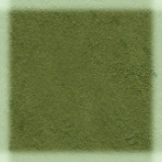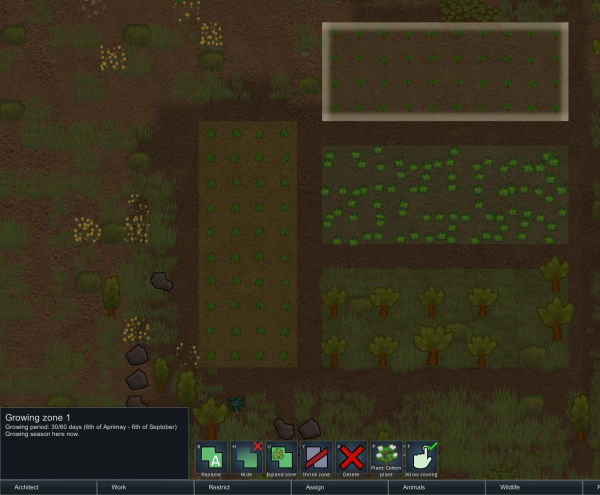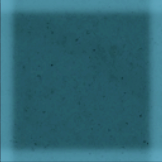Difference between revisions of "Zone/Area"
m |
Malganis75 (talk | contribs) m (Added description to area) |
||
| Line 1: | Line 1: | ||
[[Category:Main]] | [[Category:Main]] | ||
| + | Areas are used by [[colonists]] for certain tasks such as hauling or growing. Areas aren't structures, and are rather just marker areas. | ||
{| | {| | ||
|- style="vertical-align: top;" | |- style="vertical-align: top;" | ||
Revision as of 12:18, 27 October 2013
Areas are used by colonists for certain tasks such as hauling or growing. Areas aren't structures, and are rather just marker areas.
For the skill, see Plants. For the work type, see Grow.
Growing zone A zone where your colonists will try to grow a certain kind of plant. Base Stats
Building
A growing zone, or grow zone, designates where grower pawns can sow and/or harvest plants, including trees and decorative plants. They are a major source of food, wood, herbal medicine, drugs, tinctoria, and textiles like devilstrand for a colony. AcquisitionGrowing zones do not require a colonist to construct or deconstruct, nor is there a cost, work time, or skill requirements for placing them. Instead, they are simply selected from the Architect > Zone menu and placed directly on the ground by the player, similar to other zones. Environment dictates growing zone placement. Growing zones can only be placed on unroofed cells of fertile terrain. Terrain type is displayed in the lower left corner of the screen cell info by hovering the mouse over a cell with no object selected. Grow zones can't be placed on roofed or unfertile cells: sand, mud, ice, natural stone, water, or constructed floors.[Detail] Colonists will never sow growing zones on days outside of the growing period, which is a period of time varying in length according to tile latitude and biome. For example, the growing period in the northern hemisphere of the rimworld usually begins early in the month of Aprimay (spring) and ends in mid or late Septober (autumn). The local growing period is shown in the inspect pane when a growing zone is selected. The inspect pane will also detail the quantity and age of plants within the zone and a UI for zone settings. Most plants have a Min growth temperature of 0 °C (32 °F) and a Max growth temperature of 58 °C (136.4 °F). Growing zones outside these temperatures result in growth stagnation and eventual plant death. Most plants cannot grow below a light level of 51%, visible in the cell info. Colonists will not sow these squares, and existing plants will die. However, fungi crops like glowstool, agarilux and nutrifungus Summary
Terrain fertility is shown in the cell info. Fertility determines speed of plant growth, with higher fertility generally resulting in faster growth rates. All plants also have a minimum fertility requirement below which they will not grow. Fertility does not affect harvest yield, though. Types of growable terrain include rich soil, normal soil, stoney soil, lichen-covered soil in Ideology, and gravel. See Fertility for more details. Trees planted in growing zones need a 1 tile radius in all directions free of other objects or plants, even those in a separate zone. Growers will remove wild trees and plants next to growing zones to accommodate this radius. Zones set to no cutting will not cut these edge plants.
Growing zones do not require any "maintenance" from pawns, such as watering or fertilization. If none of your growers have the required minimum skill to grow a species of crop, the plant will simply not be sown. Colonists will automatically clear growing zones of rock chunks and place them around the edge of the zone without need for manual haul orders per item. Colonists also remove plants not of the type designated by the zone without the need to designate chop wood, harvest, or cut plants. When a growing zone is selected, an inspect pane and UI appears to allow the player to configure the growing zone's individual settings, including plant species to sow, renaming, resizing, hiding, toggle allowing sowing, and toggle cutting. The inspect pane will also detail the quantity and age of plants within the zone. If the zone's crop is changed and sowing and cutting are both allowed, colonists will cut any existing plants and re-sow the zone. AnalysisAllow sowing after Raids. This is true for Cassandra Classic and Phoebe Chillax. DesignAreas of rich soil should generally be prioritized for growing zone placement, but since only growth rate is affected not yield, planting larger fields of crops is roughly as work efficient. It simply takes longer to get a return, with more time and thus risk for crop damage to occur, and more travel and hauling time. Thus, while rich soil should be prioritized if convenient, it is not generally worth planting fields on the other side of the map just to exploit it. Fields nearby to your freezer or kitchen are recommended. Flooring to prevent wild plant growth allows for faster movement through your fields, while roofed walkways for the same purpose can also come in handy during winter or toxic fallout. Both can be combined. Estimating the correct size of a growing zone is not easy with so many factors and events affecting harvest. A quick rule of thumb is to grow 10+ tiles of food crops per colonist in a biome with year-round growing. If the colony hunts as well, it will accumulate some food reserves, which can be saved for winter, fed to prisoners, or sold. More crops should be planted if other factors reduce yields, such as when pawns have low average Growing skill and in biomes and latitudes with shorter growing periods. Risk ManagementRandom blight epidemics can spread to other crops of any species within a 4 tile radius. Leaving 4 tile wide gaps between your crop fields will mitigate its spread. Neither toxic fallout nor drought kills crops. Plants do not grow under light levels of 51%, such as during a solar eclipse or at night. Hostile raiders will set fire to growing zones if they get the chance. Clear all wild plants and flammable items within at least 2 tiles of growing zones to prevent the spread of fire. The use of nearby firefoam poppers or foam turrets is also recommended. Bad temperatures will stop plant growth and kill your crops. Below their Min growth temperature, individual plants will spontaneously despawn with a warning note: "x plant has died due to cold.". Thus, it is a waste of time to sow fields at the end of the growing season, as the cold will prevent your crops from reaching harvest maturity (~66% maturity.) Wild and tamed animals will eat most plants in growing zones once the plant reaches harvest age (~66% total maturity). It is advisable to use Zones to restrict tamed animals and walls/fences to keep wild beasts out. Harvesting a plant at full maturity generally yields more nutrition than consuming the growing plant. Harvesting wild plantsGrowing zones can be used to automatically harvest ambrosia sprouts or wild healroot and chop trees when they reach maturity. Forbid sowing in the growing zone but allow cutting, and colonists will automatically harvest plants within the zone when they grow to full maturity. You can double-click an empty tile inside a growing zone to highlight all growing zones on the visible portion of the map. This can be handy in a biome with winter to forbid sowing as winter approaches - but be sure to turn sowing back on before spring! Version history
See also |
Dumping area | Stockpile zone |


